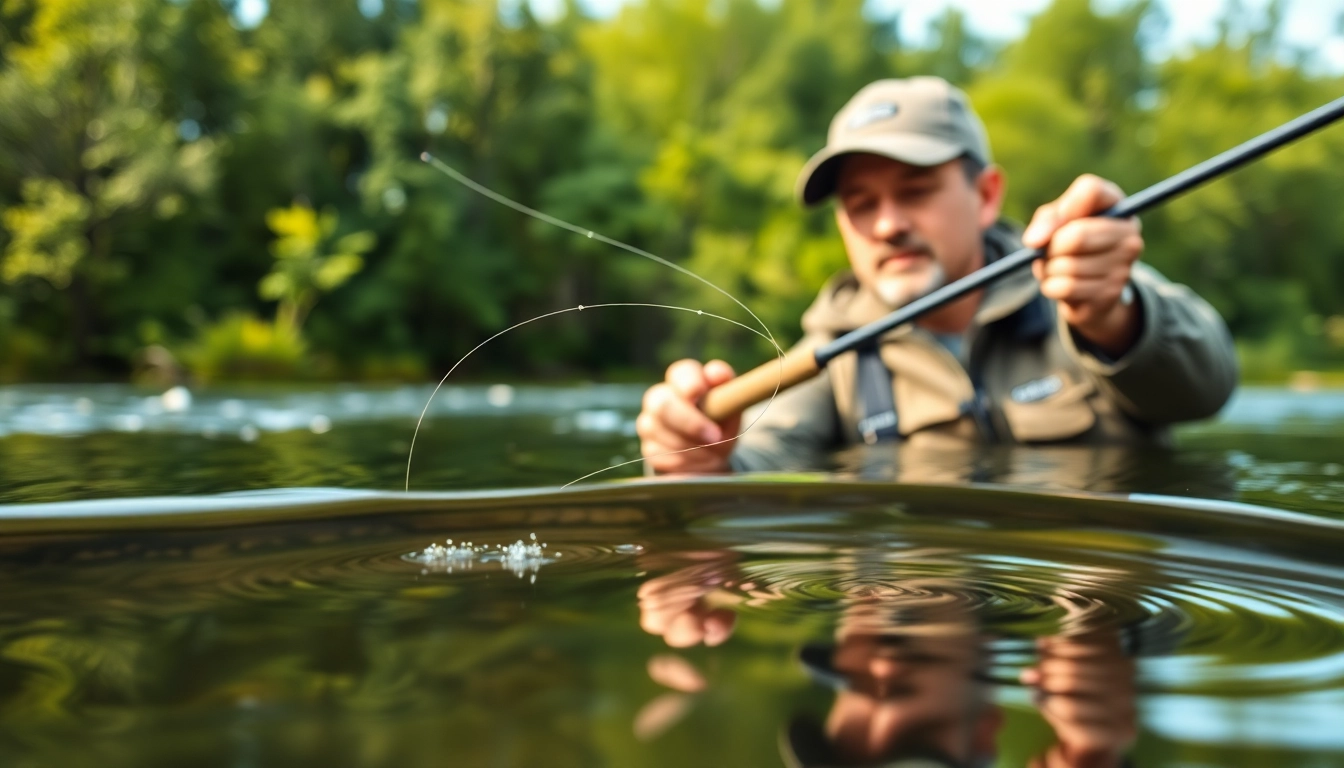Understanding Fly Fishing Line Basics
What is Fly Fishing Line?
Fly fishing line is a specialized type of fishing line designed specifically for the art and technique of fly fishing. Unlike traditional fishing lines that may rely on weights to sink bait, fly fishing lines are characterized by their buoyancy and density that allow for delicate presentations of flies. They serve multiple purposes, including carrying the weight of the fly and allowing the angler to make precise casts. Understanding the intricacies of fly fishing line is essential for any angler looking to enhance their fishing experience.
Types of Fly Fishing Line
There are several types of Fly fishing line, each suited for different fishing conditions and techniques. The most commonly used types include:
- Weight Forward (WF): This is the most popular type of fly line among anglers. It has a heavier front taper which helps in casting distance and accuracy.
- Double Taper (DT): Ideal for delicate presentations, this type features a taper on both ends, making it reversible for extended use.
- Shooting Head: Commonly used for long-distance casts, these lines feature a heavier front section and a thinner running line, often used in saltwater applications.
- Euro Nymphing Line: Specifically designed for tight-line nymphing, these lines are thinner and sink faster, providing better sensitivity.
- Sinking Lines: These lines have a heavier density, allowing them to sink quickly and reach fish that are deeper in the water column.
How Fly Fishing Line Works
The functionality of fly fishing line centers around the principles of weight and aerodynamics. When casting, the weight forward or tapered design helps load the rod, allowing the angler to cast the line and fly efficiently. The line’s buoyancy is essential for keeping the fly on or near the water’s surface, mimicking natural movement. Furthermore, the correct utilization of fly fishing line can significantly impact the effectiveness of the angler’s technique, leading to improved catch rates.
Key Features of Fly Fishing Lines
Weight and Taper Types
The weight of the fly line corresponds to the weight of the fly rod, ensuring compatibility for optimal casting performance. Lines are categorized by weight from 1 to 12, where lower numbers are suited for lighter rods and higher numbers for heavier rods.
Moreover, the taper of the line plays a vital role in casting. Lines may feature different tapers such as:
- Progressive Taper: Provides a smooth transition of weight for a versatile casting style.
- Steep Taper: Known for minimizing drag and improving accuracy in wind conditions.
- Long Taper: Offers soft presentations and is great for intricate casting scenarios.
Material and Durability Considerations
Fly fishing lines are typically made from PVC (polyvinyl chloride) or polyurethane, both of which offer different benefits regarding flexibility, toughness, and water resistance. Factors to consider include:
- Durability: Look for lines that resist abrasions and UV degradation.
- Flexibility: The right amount of suppleness can enhance casting distance and sensitivity.
- Temperature Resistance: Different materials perform differently in cold or hot conditions, affecting overall usability.
Buoyancy and Sinking Lines
Understanding buoyancy characteristics is crucial when selecting fly fishing lines. Floating lines are the most versatile and commonly used for various techniques, while sinking lines are essential for certain species or methods that require the bait to be presented at specific depths.
For example, a sink tip line has a floating body with a sinking tip. This design allows anglers to fish near the surface while still being able to reach fish actively feeding below the surface. Knowing when to select floating versus sinking lines could be the key to a successful day on the water.
Selecting the Right Fly Fishing Line
Matching Line with Rod and Reel
One of the most important considerations when choosing a fly fishing line is ensuring it matches well with your rod and reel setup. The ideal weight of the line should correspond with that of the rod. A mismatched setup may lead to poor casting performance, frustrating the angler and lowering success rates.
To properly match your line with your gear, refer to the weight rating marked on your rod and reel, generally categorized into a range of weights corresponding to the line. A sound method is to test multiple lines to find the best fit for your casting style and comfort.
Choosing Based on Fishing Conditions
Selecting an appropriate fly line also requires consideration of specific fishing conditions, such as:
- Water Type: Freshwater vs. saltwater environments can dictate the type of line necessary.
- Weather Conditions: Windy conditions may require specialized lines that minimize the adverse effects of wind.
- Target Species: Certain fish respond better to different line types; understanding the species can help tailor your choice.
Assessing Personal Skill Level
For beginners, a floating weight forward line is primarily recommended due to its versatility and ease of use. Those with more advanced skills may explore specialty lines tailored for specific techniques such as steelhead fishing or saltwater scenarios. An honest self-assessment of your skill level can go a long way in ensuring the right line selection.
Common Challenges with Fly Fishing Line
Tangling and Knots Management
Fly fishing often demands specific knots for effective line management, and learning these techniques is fundamental. However, tangling can occur frequently, particularly in windy conditions or during fast retrieves. To mitigate these issues:
- Utilize proper storage methods for your line to reduce kinks.
- Incorporate line conditioners to enhance flexibility and reduce memory-related tangles.
- Practice adept knot-tying skills to improve reliability during fishing.
Line Memory Issues
Line memory refers to the tendency of a fly line to retain coiled shapes from packaging, which can affect casting accuracy and line performance. To combat line memory issues:
- Store lines on the reel when not in use to maintain their original shape.
- Occasionally stretch the line in the opposite direction to help eliminate any memory issues.
- Make regular checks for tangles and knots during your time fishing.
Maintaining Line Performance
Regular maintenance is vital to extending the life and performance of your fly fishing line. After each fishing trip, rinse the line with fresh water to remove dirt, sand, and salt deposits that may otherwise cause deterioration. Furthermore, inspect the line for any abrasions that may require replacement. Regular conditioning can significantly enhance performance, maintain pliability, and prevent wear and tear over time.
Advanced Techniques for Fly Fishing Line Usage
Optimizing Your Casting Technique
To maximize the effectiveness of your fly fishing line, proper casting technique is of paramount importance. Utilizing a double haul, which involves pulling the line with the non-casting hand while casting, adds distance and speed to your cast. Practicing various casting strokes will improve your accuracy and distance, ensuring that you can deliver your fly precisely where it needs to land.
Improving Accuracy and Distance
Improving casting accuracy and distance requires an understanding of your fly line, rod, and the conditions you are fishing. Using a line with the correct taper can significantly enhance your cast, allowing for flexibility in technique. Practicing in diverse conditions—such as varying wind or water temperatures—will help you adapt your style and improve overall proficiency. Furthermore, familiarizing yourself with the characteristics of your fly line will enable precise adjustments during your fishing endeavor.
Adjusting Line for Specific Species
Each species of fish can have specific preferences for how flies are cast and presented. For example, trout may be more responsive to floating lines at dawn or dusk while bass may find sinking lines more appealing in mid-day heat. Understanding these subtleties and adjusting your line to accommodate the species can improve your chances of success. Consider the feeding habits and behaviors of your target species to select the most appropriate line and technique.



